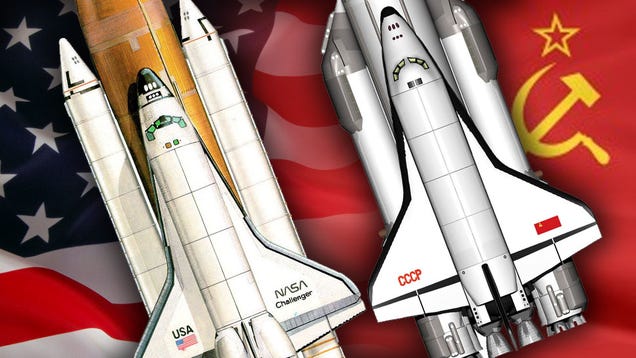
For some reason, my social media feeds lately have been filled with images of “Russia’s secret space shuttles”
that have fallen into ruin. This is a little puzzling, since those
shuttles haven’t been ‘secret’ for decades, and they’ve been in terrible
condition for over 20 years. But that got me thinking — was it a better
Space Shuttle than the American one?

The reason
we’ve been seeing so much old Soviet shuttle-related content recently is
that a photographer named Ralph Mirebs recently took a trip to the
launch facility at Baikonur and took a lot of amazing pictures of the very sad state of the ex-Soviet Shuttle fleet. The original orbiter, Buran,
is there, but a roof collapse in 2002 has pretty much ruined it.
There’s an atmospheric test orbiter, and the almost-completed second
orbiter, Ptichka, left to decay.
They’re
striking, melancholy photos to look at, stark reminders of dreams
unrealized and wasted potential. But all this attention on the old Buran
does give us a good opportunity to really look at what the Soviets made
there, and wonder, uselessly and in hindsight, if maybe, just maybe,
their space shuttle system might have been superior to ours.
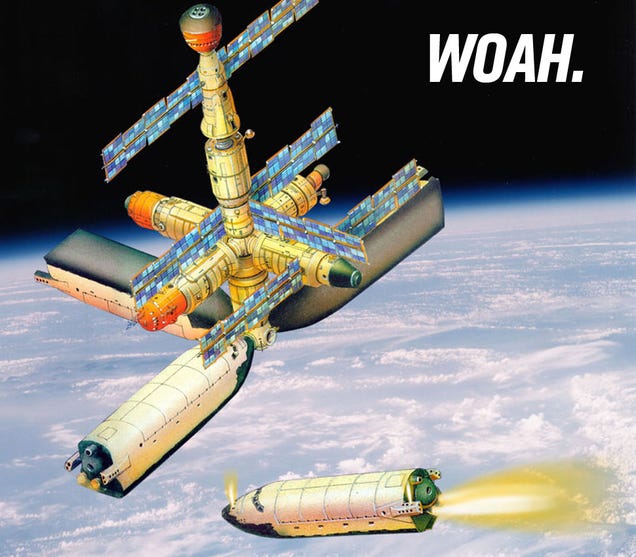
The Soviet
space shuttle program came about as a direct response to the U.S. Space
Shuttle program, because the Soviets saw the U.S. shuttles as primarily
military spacecraft, ones that would eventually be configured to carry
nuclear bombs. As a result, the Soviet program was highly military in
nature, with all manner of strange and ominous mission plans and Buran
variants (even some really odd wingless versions) being developed to create in-space nuclear weapon launchers and military space stations.
Most people
assume the Soviet space shuttles were just a cheap knockoff of the
American shuttles because the orbiters look really, really similar. The
truth is way more complex, but a simple answer is that’s sort of half
right. The Buran’s basic look and shape was, pretty much, taken from the US shuttles, because even though the Soviets experimented with a lot of quite different-looking concepts,
they never found one was that qualitatively better, aerodynamically,
from what the U.S. was doing, and since the U.S. had gone through the
considerable trouble of proving the design worked by actually launching
and conducting missions, there really wasn’t any compelling reason not to just duplicate the basic orbiter design.

That said,
internally, the Buran was very different than the U.S. shuttle, and when
you look at the entire (as the NASA liked to call it) Space
Transportation System, the advantages of the Soviet approach become
apparent. To see what I mean, let’s look at the two orbiter designs side
by-side:
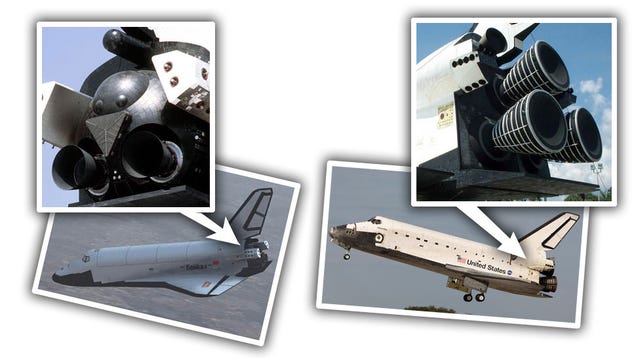
What’s the
biggest difference there? Look at the rear of the orbiters. You’ll
notice that the U.S. shuttles have five total engines at rear — two
orbital maneuvering engines (OMS) and three very large main engines,
used at launch. The Buran has only the two orbital maneuvering engines,
along with a bunch of smaller attitude control thrusters.
So, why the
difference? The answer has to do with the launch vehicles. The US
shuttle uses those three main engines to launch it from the earth into
orbit. To feed all the fuel to those engines, the U.S. uses that big,
central orange external tank.
But there’s
a problem: those three main engines aren’t strong enough to lift the
orbiter and all that fuel off the ground. So, to get everything going
high and fast enough to get into orbit, we added the pair of powerful
solid rocket boosters (SRBs) to the sides of the tank. So, the SRBs do
most of the heavy lifting to get to orbit, and the three main engines
take over to do the last leg, acting as a sort of second stage.
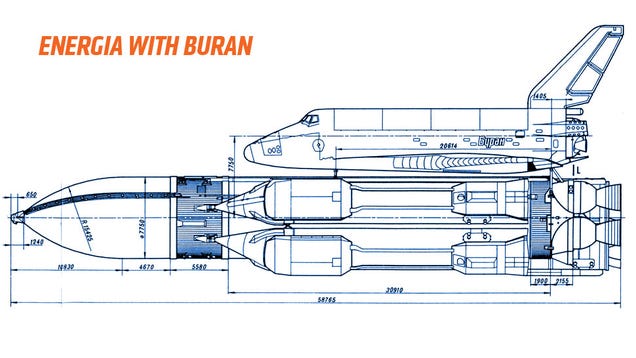
Once in
orbit, those three engines are heavy deadweight. They take up space and
mass that could otherwise have been used for payload on the orbiter. For
all in-orbit maneuvering, the OMS engines are used. For 99% of the
shuttles’ mission, those three main engines are useless mass that has to
be brought back home at the end.
The more
you think about our solution, the crazier it sounds. If those engines
can’t lift their fuel, and are then useless when in orbit, why are we
dragging them to and from space every mission? Isn’t there a better way
to do this?

Turns out, there is, and that’s exactly what the Soviets figured out. Really, they sort of had
to figure out another way to do this, since their solid-fuel rocket
technology was lagging behind the US. So, they made an extremely large
and powerful liquid-fueled rocket that, crucially, did nearly all the
work of getting the Buran into orbit. The Buran fired its OMS engines
for a very final little kick to the proper orbit, but the large rocket
assembly, called Energia, did the work, and Buran was just a payload.
What this
meant is that the Buran didn’t need to carry three big, useless-in-space
engines with it for every mission, and that made it weigh less (by
about 8 tons) and gave it a payload capacity larger than the U.S. shuttle
— where the U.S. shuttle could generally carry about 25 tons up and 15
down, the Buran was capable of about 5 tons more on both those numbers.
But, even
more important is the realization that in the Soviet approach, the Buran
orbiter is just payload for the Energia, not an integral part of the
system, like the U.S. Shuttle. That means that the Soviet space shuttle
program really got two very separate and capable vehicles from the
program: a re-usable space plane with a launch system and a general-use heavy-lift launcher.
The Energia
without the Buran orbiter could launch an astounding 95 tons into orbit
— NASA is only just now planning a new heavy-lift launcher that beats
that, the Space Launch System.
NASA’s SLS heavy-lift rocket is actually sort of an Energia-style
rocket built from Space Shuttle Launch System-derived components.
The Energia
was only used to launch something other than the Buran once, the black,
ominous-looking secret military spacecraft called Polyus.
Polyus was an orbital weapons platform armed with a 1-megawatt laser,
designed to destroy satellites. Perhaps luckily for us, it suffered a
maneuvering error shortly after orbital insertion and burned up in the
atmosphere.
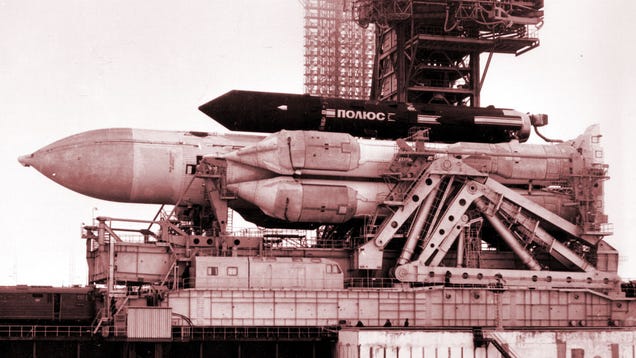
There was
another advantage, and this one is really, really significant from a
safety perspective: you can turn the Energia off. That may sound weird
until you remember that the SRBs used on NASA’s shuttle cannot
be shut off after they start — this is one of the inherent disadvantages
of solid-fuel rockets. NASA realized the importance of this after the
Challenger disaster, and it’s actually still an issue with the upcoming
SLS rockets NASA is currently developing. Liquid fuel gives the Energia
system a huge safety advantage.
So, the
Soviet space shuttle solution could carry more payload and provided a
general-use heavy-lift booster as well that was far safer than the
solid-fuel solution used in the US. Those are the big advantages, but
there’s actually one more, one that was demonstrated during the Buran’s
first and only flight.
When the U.S. launched our first shuttle, Columbia,
in 1981, it had the minimum crew possible — two astronauts. This is, of
course, a prudent move when testing a brand-new spacecraft. When the
Soviets launched Buran in 1988, it went even further — no crew at all.
The Buran
was certainly going to be a crew-carrying vehicle, and it even launched
with a special diagnostic module that also offered a bit of extra crew
space, much like the SpaceLab modules that flew on NASA’s shuttles. But
the Buran was capable of fully autonomous flight, something the U.S.
shuttles never even attempted.
The Buran
launched, did two orbits, and landed like an airplane all under
automatic control — that’s a pretty significant achievement. Such
capability is actually quite useful for a space shuttle orbiter, as it
would allow for an unmanned rescue shuttle to be launched in situations
where a crew may have been stranded due to issues with their shuttle,
such as the tile-damage issue that caused the destruction of the
Colombia orbiter. NASA spent a lot of time trying to figure out how to
cram a full crew into a rescue shuttle flown up by even as few as two
astronauts.

The Soviet
Energia-Buran system did have some real technical advantages over the
NASA Space Shuttle program. But, NASA did manage to do a hell of a lot
more with their program, like, you know, actually going to space and
doing interesting things. In an ideal world, there would have been
cooperation, and perhaps US orbiters could have been retrofitted to work
with Energia launchers, and perhaps we’d even have been able to use Energia rockets for Mars missions
and and and we’d have permanent lunar bases and Space Unicorns and
Infinite Energy satellites that run on rainbows and love and and and...
Sorry. I guess that’s just not the way the world works.
The Space Shuttle’s Military Launch Complex In California That Never Was
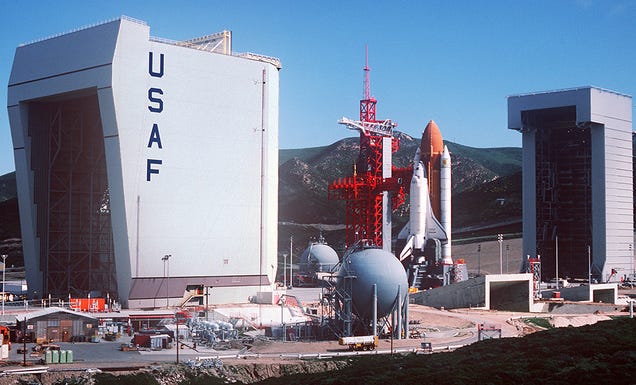
Everybody
identifies Kennedy Space Center and Johnson Space Center as the
epicenters of America’s now defunct Space Shuttle Program. What most
people don’t know is that the Shuttle almost had a second home at
Vandenberg Air Force Base on the south central coast of California.
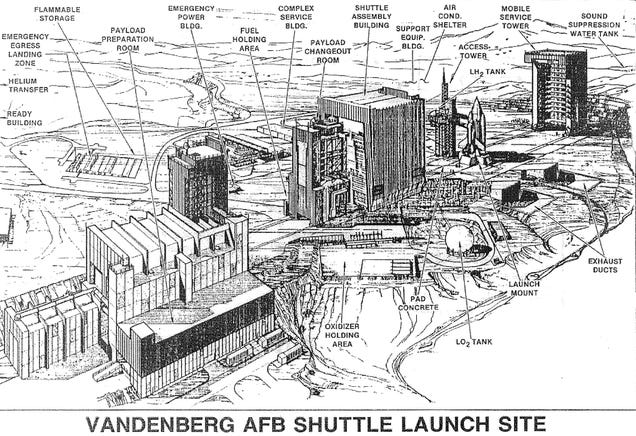
For the last quarter of the 20th Century, launch pads 39A and 39B, the massive Vehicle Assembly Building, the sprawling Shuttle Landing Facility, the iconic Launch Control Center, the Orbiter Processing Facility and the Crawler Transporters were all icons of Kennedy Space Center.
Set among
the lush backdrop of the Merritt Island Wildlife Refuge, on the central
east coast of Florida, like the massive Apollo rockets that came before
it and took man to the moon, this sprawling combination of
infrastructure would be the operational home of America’s Space Shuttle
Program — at least, NASA’s side of it.
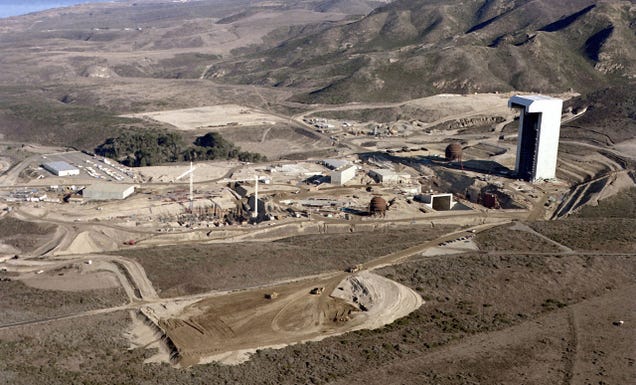
While the
Shuttle program was still getting off the ground (pun very much
intended!), a miniaturized version of KSC’s Launch Complex 39 was being
quietly built at Vandenberg AFB. Compared to the long distances and flat
topography that separated critical and in some cases volatile
infrastructure at Kennedy Space Center in Florida, Vandenberg’s compact
Space Launch Complex Number 6 looked more like an elaborate Hollywood
set of some evil villain’s secret space project, not another Space
Shuttle launch facility.
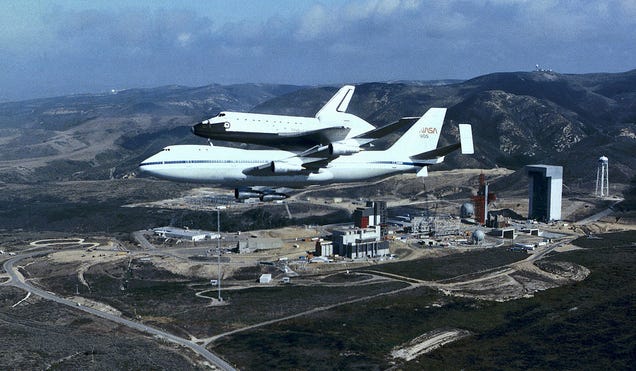
Looking at pictures of the facility today conjures images of Moonraker.
But it was here, at SLC-6, that the Air Force was planning on launching
dozens of Shuttle missions, lofting and servicing everything from spy
satellites to exotic “Star Wars” weapons platforms into space.
The
Pentagon, along with their NASA partners, had bet heavily on the idea of
a reusable ‘space plane’ for their orbital needs. High hopes were
placed on the Shuttle’s ability to deliver reliable and constant access
into low-earth orbit. Sadly, these hopes would prove hollow as the
luster of the idea of a true Space Shuttle collided with the gritty
realities of the real Space Shuttle’s actual design and the limits of
its 1970’s era technology.
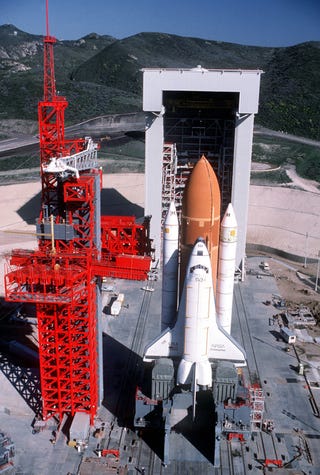
In summary,
the U.S. Air Force alternative launch facility would largely support
the ‘dark arm’ of the Shuttle program, one based around shadowy military
payloads, not white-world science and discovery. Kennedy Space Center
could also support these types of mission to a certain degree, although
crucial polar orbit flights that were preferred for spy satellites were
out of the question if they originated from KSC.
Such a
flight path would send the Shuttle over populated areas during launch,
traveling over an area ranging from South Carolina to the Great Lakes.
The Shuttle’s boosters would drop somewhere near Brunswick, Georgia, and
its main tank would end up whipping around the globe over Russia and
China, and ending up in the Indian Ocean... Hopefully.
All this,
as well as payload limiting issues, precluded Kennedy Space Center as a
launch site for polar orbit flights. On the other hand, Vandenberg AFB’s
locale had no such limitations, with the Shuttle being able to launch
on a southwesterly direction over the Pacific on its way to polar orbit
without any reservations about public safety and with little negative
impact on the Shuttle’s potential payload for such a flight profile.
Vandenberg’s
Space Launch Complex Six (SLC-6) was originally designed and built at a
very high coast (some say $3B) as the launch pad for Titan II rockets
that would support the 1960s equally as Bond-esque ”Manned Orbiting Laboratory.” Basically,
this concept was a spy satellite-like space station that would be
manually operated by astronauts for extended periods of time. The
program was cancelled in 1969 as unmanned satellites could get the job
done at a fraction of the cost and without the risk to human life.
Looking back, this was an eerie foreshadowing of things to come for
SLC-6’s next tenant.
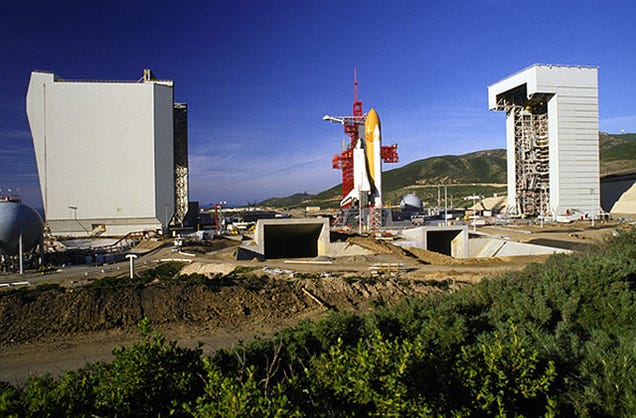
A half
decade or so later, the Shuttle Program was being developed at a rapid
pace and the military wanted to take advantage of this new technology.
In 1974, the then-defunct Space Launch Complex Six (nicknamed “Slick
Six″) was reborn into the military Space Shuttle’s new west-coast home.
Construction at the site began in 1979 and was mostly completed by 1985,
with the Defense Department going so far as having the aerodynamic test
Orbiter, the Enterprise, mocked up on the pad complete with
its external tank tank and boosters. This was done to validate the pad’s
proper fitment for Shuttle Launch System. This event also offered many
of the pictures you see in this article.
Once the Enterprise arrived,
the shuttle stack was assembled right on the pad, just as it would be
during a real pre-launch evolution. This was far different than doing
the complex and somewhat dangerous task at a dedicated Vehicle Assembly
Building, like the one that sits some three and a half miles away from
the launch pads at Kennedy Space Center.
During
normal operations, SLC-6 would have had its orbiter delivered via
roadway from a processing facility built 16 miles to the north, near
Vandenberg AFB’s main runway. The Shuttle’s main fuel tank would have
been delivered by barge from Louisiana and its boosters would be
delivered in sections by train. Upon splash down, recovery of the
Shuttle’s spent boosters and fuel tank would managed by Naval Surface
Warfare Center Hueneme in Oxnard, California.
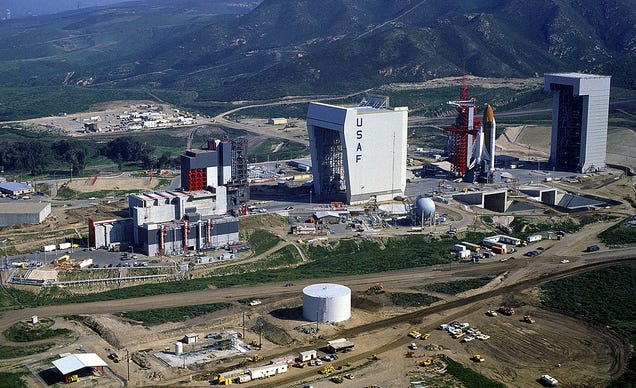
The whole
setup was eerily compact for those who had brought the Space Shuttle to
life at Kennedy during the half decade prior, and because of the
secretive payloads that would be launched out of SLC-6, the whole
operation had a high-security military twist to it. The safety of
distance that was omni-present at Kennedy Launch Complex 39
was all but erased at SLC-6. Even the launch team and control was going
to be located right at the launch complex in a fortified control center
just 1,200 feet from the pad!
The small
size of the facility was especially troubling considering the amount of
damage a shuttle stack could do during a catastrophic failure on the
launch pad or during assembly, an event that has been commonly described
as analogous to a nuclear explosion. How accurate this description is
remains unclear, but there is no doubt that the shuttle stack is a
dangerous thing when sitting on the pad ‘cocked and locked.” Even when
unfueled, the Shuttle’s Solid Rocket Boosters (SRBs) are 150 foot tall tubes packed with highly explosive material that has no ‘off switch’ once they are ignited.
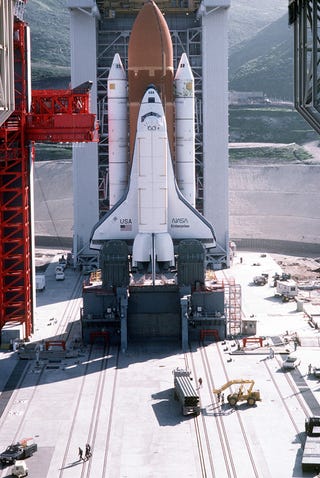
After fitment checks were complete, the first flight of a USAF controlled Shuttle mission from SLC-6, dubbed officially STS-62-A, was slated to be made by Discovery — which was to be the USAF’s dedicated Orbiter — on
October 15th, 1986. The launch would put the Orbiter into polar orbit
where its crew would deploy the highly classified Teal Ruby experimental
surveillance craft and operate a package of classified sensors that
were to be installed in Discovery’s expansive payload bay.
Then, on January 28th 1986, Challenger blew
up shortly after launch, grounding the already delayed and far
over-budget Space Shuttle Program indefinitely. This left the Air Force
and the Defense Department to re-think their planned reliance on the
costly and seemingly unreliable Shuttle for heaving critical and very
expensive spy and communications satellites into orbit. The truth is
that the Shuttle’s capability to provide anywhere near the number of
flights that the program had promised was largely in question long
before the loss of Challenger. With all this in mind, the
decision was made to put SLC-6 on caretaker status and by 1989 the
Pentagon’s Shuttle Program was officially shuttered.
In the end,
11 Shuttle flights did carry classified payloads into orbit for the
military from 1982 to 1992, albeit none reached polar orbit as all were
launched form KSC.
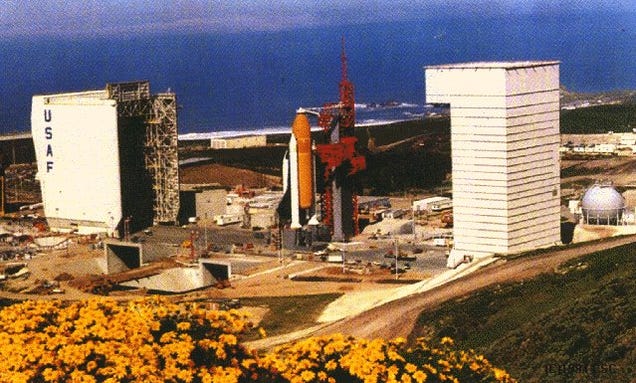
The fact
that the Shuttle never used SLC-6 may have been a good thing in
retrospect. There were numerous integration issues and unsolved problems
with the site during its construction, and it seemed like as soon as
one issue was solved another would pop up. Acoustic suppression was one
of these problems that first reared its head when Columbia was launched from KSC in 1981, marking the Shuttle’s first flight.
During Columbia’s
launch, the acoustic waves that bounced back off the pad from the
Shuttle’s main engines and its solid rocket boosters were so powerful
that they could have caused the stack to rip itself apart, killing all
onboard and destroying the Shuttle and its surrounding infrastructure in
the process.
An
elaborate water acoustic suppression system was added to Kennedy’s 39A
and 39B launch pads after that inaugural flight in an attempt to deaden
the damaging sound waves. Although SLC-6 was built with a water acoustic
suppression system, it was a totally different and a much more modular
design than KSC’s. This system would have only been validated during an
actual Shuttle launch and there were concerns that there was not enough
water onhand or enough storage for the contaminated waste water after
the launch.
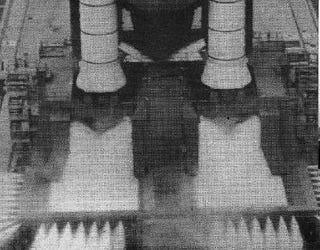
Nearby
cliffs could have also bounced shock waves back at SLC-6 during launch,
which could have caused damage to buildings and the shuttle itself, or
even worse. Weather was also an issue, with high winds and cold
temperatures, along with dense fog, being a regular issue at Vandenberg
AFB. As such, the rolling shed-like buildings that covered the launch
pad could be rolled into place around the shuttle stack, but these were
austere structures and paled in comparison to the well-built and climate
controlled interior of the Vehicle Assembly Building at Kennedy Space
Center.
By the mid
1980s, the potential hazard of trapped liquid hydrogen during launch
also became a huge issue with SLC-6s compact design and its reused
exhaust ducts. It was feared that ambient hydrogen could ignite a fire
below the Shuttle during launch, causing an explosion that would blow
the Shuttle’s tail apart as it was lifting off the pad or even after an
emergency engine shutdown.
The
Shuttle’s acoustic and hydrogen abatement issues, along with the danger
from the raw heat and blast of the Shuttle’s engines and SRBs during
launch to the nearby structures, could have all ended up being
non-factors. Still, just as mentioned earlier, there is no denying that
SLC-6’s launch pad design and the Shuttle’s close proximity to its
service structures and critical infrastructure, could have led to
massive disaster if the there was a catastrophic accident during
assembly or launch. Additionally, the shaking and concussion from
launches may have demanded heavy maintenance to the facility after every
launch, with nearby delicate computer systems being a major concern.

After the
cancellation of the Defense Department’s arm of the Shuttle Program,
SLC-6 was used by multiple defense contractors with varying results (see a full launch list here).
By the early 2000s, a legend that the complex was badly cursed had
grown to massive proportions, as so many billions of dollars had been
poured into the installation, under the guise of a whole slew of
programs, with very little to show for it in the end.
Finally, in the mid 2000s, Boeing took over the facility and re-utilized much of the Shuttle’s infrastructure for their Delta IV rocket program. The first Delta IV Medium rocket was
triumphantly launched from the long beleaguered complex in 2006. Since
then, the once doomed SLC-6 has performed extremely well launching large
payloads into space, most of which contain America’s most high-tech and
secretive space-based spying technologies. This is somewhat of an
ironic reprieve for the site as it had unsuccessfully been envisioned as
facilitating just that mission for close to half a century.

Photos via USAF and NASA


No comments:
Post a Comment